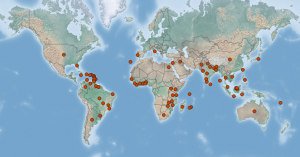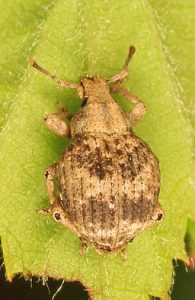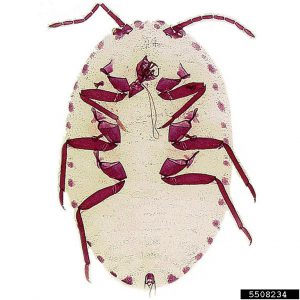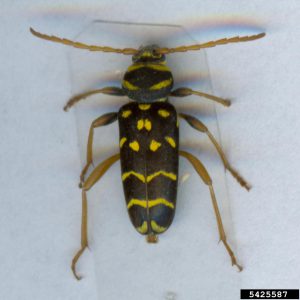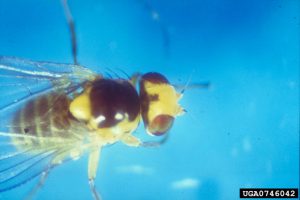California Pest Rating for
Hemiberlesia palmae (Cockerell): Tropical palm scale
Hemiptera: Diaspididae
Pest Rating: A
PEST RATING PROFILE
Initiating Event:
A permanent pest rating proposal is required to support an official pest rating.
History & Status:
Background: Hemiberlesia palmae is a widely-distributed armored scale. This highly polyphagous species has been reported to feed on plants in at least 92 genera in 53 families. Reported hosts include avocado, banana, bromeliads, cactus, citrus, coffee, mango, olive, palms (including coconut), and at least one species of fern (Agricultural Research Service, 1969; García Morales et al., 2016; Kondo and Muñoz, 2016; McKenzie, 1956; Santos and Wolff, 2015; Sepúlveda et al., 2010; Thuy et al., 2011). Although it is a widespread species and feeds on many economically-important plants, no information was found suggesting that it is a significant pest (Dekle, 1976; Granara De Willink and Claps, 2003; Nuñez, 2008). Feeding is reported to cause yellow spots on leaves (Schmutterer, 1971). Hemiberlesia palmae is reported to be parthenogenetic (Brown, 1965).
Worldwide Distribution: Hemiberlesia palmae is apparently of neotropical origin, but it has been established over a wide area. It has been reported from Europe (including Spain, Portugal, and in greenhouses in the United Kingdom), Africa (including Angola, Cameroon, Ghana, Kenya, South Africa, Tanzania, and Zaire), Asia (including China, India, Indonesia, Philippines, Thailand, and Vietnam), Australia, the Caribbean (including Antigua and Barbuda, Cuba, and Jamaica), Central America (including Guatemala and Panama), New Guinea, numerous Pacific islands, South America (including Argentina, Bolivia, Brazil, Chile, Colombia, Ecuador, and Peru), and North America (Mexico and the United States, where it is reported from Alabama, Florida, and Puerto Rico) (Amún and Claps, 2015; Ben-Dov and Sánchez-García, 2015; Culik et al., 2011; De Lotto, 1967; Franco et al., 2011; García Morales et al., 2016; Germain et al., 2008; González and Charlín, 1968; Granara De Willink and Claps, 2003; Kondo and Muñoz, 2016; Malumphy, 2012; Malumphy, 2014; Miller, 2005; Ponsonby, 1994; Szent-Ivany and Catley, 1960; Thuy et al., 2011; Vasquez et al., 2002; Waltman et al., 2016; Williams, 1973). Some (possibly most) of the records from more temperate areas (e.g., Europe) were associated with greenhouses.
Official Control: Hemiberlesia palmae is regulated in New Zealand and is a controlled pest in Korea (Food and Agriculture Organization, 2016).
California Distribution: Although Hemiberlesia palmae has been found at various times in nurseries in California, it is not currently known to be established in the state.
California Interceptions: Hemiberlesia palmae has been intercepted numerous times on plant material from various origins, including Florida, Central America, and South America (California Department of Food and Agriculture).
The risk Hemiberlesia palmae would pose to California is evaluated below.
Consequences of Introduction:
1) Climate/Host Interaction: Hemiberlesia palmae is highly polyphagous and availability of host plants is not likely to limit its potential distribution in California. The known distribution of this species includes many tropical and subtropical areas, but some records are from desert areas as well, for example, the Azapa Valley in Chile (González and Charlín, 1968). It seems likely that climate would limit the potential distribution of this scale to the warmer southern portions of the state. Therefore, Hemiberlesia palmae receives a Medium (2) in this category.
– Low (1) Not likely to establish in California; or likely to establish in very limited areas.
– Medium (2) may be able to establish in a larger but limited part of California.
– High (3) likely to establish a widespread distribution in California.
2) Known Pest Host Range: Hemiberlesia palmae is highly polyphagous and has been reported to feed on plants in at least 53 families. Therefore, it receives a High (3) in this category.
– Low (1) has a very limited host range.
– Medium (2) has a moderate host range.
– High (3) has a wide host range.
3) Pest Reproductive and Dispersal Potential: Hemiberlesia palmae apparently has high reproductive and dispersal potential. It is parthenogenetic, so a female does not have to mate to produce viable offspring. The frequent interceptions on plant material indicate that it could be spread through that pathway. Therefore, it receives a High (3) in this category.
– Low (1) does not have high reproductive or dispersal potential.
– Medium (2) has either high reproductive or dispersal potential.
– High (3) has both high reproduction and dispersal potential.
Economic Impact: Hemiberlesia palmae is regulated by some countries, and if it became established in California, this could lead to the loss of markets. If control measures were taken by growers to control this scale, it would likely increase production costs. Therefore, it receives a Medium (2) in this category.
Economic Impact: B, C
A. The pest could lower crop yield.
B. The pest could lower crop value (includes increasing crop production costs).
C. The pest could trigger the loss of markets (includes quarantines).
D. The pest could negatively change normal cultural practices.
E. The pest can vector, or is vectored, by another pestiferous organism.
F. The organism is injurious or poisonous to agriculturally important animals.
G. The organism can interfere with the delivery or supply of water for agricultural uses.
Economic Impact Score: 2
– Low (1) causes 0 or 1 of these impacts.
– Medium (2) causes 2 of these impacts.
– High (3) causes 3 or more of these impacts.
5) Environmental Impact: If Hemiberlesia palmae became established in California, it would likely attack a wide variety of crop and ornamental plants, and this could trigger treatments. Therefore, it receives a Medium (2) in this category.
Evaluate the environmental impact of the pest on California using the criteria below.
Environmental Impact: D
A. The pest could have a significant environmental impact such as lowering biodiversity, disrupting natural communities, or changing ecosystem processes.
B. The pest could directly affect threatened or endangered species.
C. The pest could impact threatened or endangered species by disrupting critical habitats.
D. The pest could trigger additional official or private treatment programs.
E. The pest significantly impacts cultural practices, home/urban gardening or ornamental plantings.
Environmental Impact Score: 2
– Low (1) causes none of the above to occur.
– Medium (2) causes one of the above to occur.
– High (3) causes two or more of the above to occur.
Consequences of Introduction to California for Hemiberlesia palmae: Medium (12)
Add up the total score and include it here.
–Low = 5-8 points
–Medium = 9-12 points
–High = 13-15 points
6) Post Entry Distribution and Survey Information: Although Hemiberlesia palmae has been found in various nurseries in California, it has apparently been eradicated whenever found and is not considered to be established in the state. It receives a Not established (0) in this category.
–Not established (0) Pest never detected in California, or known only from incursions.
–Low (-1) Pest has a localized distribution in California, or is established in one suitable climate/host area (region).
–Medium (-2) Pest is widespread in California but not fully established in the endangered area, or pest established in two contiguous suitable climate/host areas.
–High (-3) Pest has fully established in the endangered area, or pest is reported in more than two contiguous or non-contiguous suitable climate/host areas.
Final Score:
7) The final score is the consequences of introduction score minus the post entry distribution and survey information score: Medium (12)
Uncertainty:
There is significant uncertainty regarding the ability of this scale to inflict significant damage on plants in California. Although this scale is widespread and feeds on a wide diversity of plants, including many economically important ones, no information was found quantifying damage caused by this feeding.
Conclusion and Rating Justification:
Hemiberlesia palmae is a highly polyphagous scale that could become a pest in California if it became established here. In addition, it is regulated by some countries and its presence in the state could impact trade. It is not known to be present in California. For these reasons, an “A” rating is justified.
References:
Agricultural Research Service. 1969. Cooperative economic insect report 19. United States Department of Agriculture, Agricultural Research Service, Plant Pest Control Division, Survey and Detection Operations.
Amún, C. and Claps, L. E. 2015. Listado actualizado de diaspídidos sobre frutos tropicales y primer registro de Pseudaulacaspis cockerelli (Cooley) (Hemiptera: Diaspididae) para la Argentina. Insecta Mundi 0449:1-11.
Ben-Dov, Y. and Sánchez-García, I. 2015. New data on several species of scale insect (Hemiptera: Coccoidea) from southern Spain. Boletín de la Sociedad Entomológica Aragonesa 56:313-317.
Brown, S.W. 1965. Chromosomal survey of the armored and palm scale insects (Coccoidea: Diaspididae and Phoenicoccidae). Hilgardia 36:189-294.
California Department of Food and Agriculture. Pest and damage record database. Accessed July 3, 2018:
https://pdr.cdfa.ca.gov/PDR/pdrmainmenu.aspx
Culik, M. P., Wolff, V. R. S., Peronti, A. L. B. G., Ben-Dov, Y., and Ventura, J. A. 2011. Hemiptera, Coccoidea: Distribution extension and new records for the states of Espírito Santo, Ceará, and Pernambuco, Brazil. Check List 7:567-570.
Dekle, G. W. 1976. Florida Armored Scale Insects. Florida Department of Agriculture, Division of Plant Industry, Gainesville, Florida.
De Lotto, G. 1967. A contribution to the knowledge of the African Coccoidea (Homoptera). Journal of the Entomological Society of South Africa 29:109-120.
Food and Agriculture Organization. 2016. List of quarantine pests in Korea. Accessed July 6, 2018:
https://www.ippc.int/en/countries/republic-of-korea/reportingobligation/2014/04/the-list-of-quarantine-pest-2013/
Franco, J. C., Russo, A., and Marotta, S. 2011. An annotated checklist of scale insects (Hemiptera: Coccoidea) of Portugal, including Madeira and Azores Archipelagos. Zootaxa 3004:1-32.
García Morales, M., Denno, B. D., Miller, D. R., Miller, G. L., Ben-Dov, Y., and Hardy, N. B. 2016. ScaleNet: A literature-based model of scale insect biology and systematics. Accessed July 20, 2018:
http://scalenet.info
Germain, J. F., Attie, M., Barbet, A., Franck, A., and Quilici, S. 2008. New scale insects recorded for the Comoros and Seychelles Islands. pp. 129–135. In Branco, M., J. C. Franco, and C. J. Hodgson. [Eds.]. Proceedings of the XI International Symposium on Scale Insect Studies, Oeiras, Portugal, 24–27 September 2007. ISA Press. Lisbon, Portugal. 322 pp.
González, R. H. and Charlín, R. 1968. Nota preliminar sobre los insectos coccoideos de Chile. Revista Chilena de Entomología 6:109-113.
Granara De Willink, M. C. and Claps, L. E. 2003. Cochinillas (Hemiptera: Coccoidea) presents en plantas ornamentals de la Argentina. Neotropical Entomology 32:625-637.
Kondo, T. and Muñoz, J. A. 2016. Scale insects (Hemiptera: Coccoidea) associated with avocado crop, Persea americana Mill. (Lauraceae) in Valle del Cauca and neighboring departments of Colombia. Insecta Mundi 0465:1-24.
Malumphy, C. 2012. Arthropods intercepted on air plants (Tillandsia spp.) imported from Guatemala into England and Wales. Entomologist’s Gazette 63:54-62.
Malumphy, C. 2014. An annotated checklist of scale insects (Hemiptera: Coccoidea) of Saint Lucia, Lesser Antilles. Zootaxa 3846:069-086.
McKenzie, H. L. 1956. The Armored Scale Insects of California. University of California Press, Berkeley, California.
Miller, D. R. 2005. Selected scale insect groups (Hemiptera: Coccoidea) in the southern region of the United States. Florida Entomologist 88:482-501.
Nuñez, E. 2008. Plagas de paltos y cítricos en Perú. 324-344 in Ripa, R. and Larral, P. (eds.) Manejo de Plagas en Paltos y Cítricos. Instituto de Investigaciones Agropecuarias, La Cruz, Chile.
Ponsonby, D. J. 1994. Biological control of glasshouse scale insects using the coccinellid predator, Chilocorus nigritus. Ph.D. thesis. University of London.
Santos, M. G. and dos Santos Wolff, V. R. 2015. Two species of armored scale insects (Hemiptera: Diaspididae) associated with sori of ferns. EntomoBrasilis 8:232-234.
Schmutterer, H. 1971. Contribution to the knowledge of the crop pest fauna in Ethiopia. Zeitschrift für Angewandte Entomologie 67:371-389.
Sepúlveda C., G., Vargas C., H., Bobadilla G., D., Cajías A., E., and Gallo D., P. 2010. Protocolos de manejo de plagas bajo criterios de producción limpia en olivo. pp. 83-105 in A. Villavicencio and F. Tapia (eds.), Formulación de sistemas de producción limpia para los principales cultivos del valle de Azapa. Proyecto Innova Chile de Corfo, Arica, Chile.
Szent-Ivany, J. J. H. and Catley, A. 1960. Host plant and distribution records of some insects in New Guinea and adjacent islands. Pacific Insects 2:255-261.
Symbiota Collections of Arthropods Network. Accessed July 20, 2018:
http://scan1.acis.ufl.edu
Thuy, N. T., Vuong, P. T., and Hung, H. Q. 2011. Composition of scale insects on coffee in Daklak, Vietnam and reproductive biology of Japanese mealybug, Planococcus kraunhiae Kuwana (Hemiptera: Pseudococcidae). Journal of the International Society for Southeast Asian Agricultural Sciences 17:29-37.
Vasquez, J., Delgado, C., Couturier, G., and Ferrero, D. M. 2002. Les insectes nuisibles au goyavier (Psidium guajava L.: Myrtaceae) en Amazonie péruvienne. Fruits 57:323-334.
Waltman, K. G., Ray, C. H., and Williams, M. L. 2016. The armored scale insects (Hemiptera Diaspididae) of Alabama, USA. REDIA 99:229-231.
Williams, D. J. 1973. Scale insects (Homoptera: Coccoidea) on macadamia. Journal of the Australian Entomological Society 12:81-91.
Responsible Party:
Kyle Beucke, 1220 N Street, Room 221, Sacramento, CA, 95814, 916-403-6741, plant.health[@]cdfa.ca.gov
Comment Period:* CLOSED
8/22/18 – 10/6/18
*NOTE:
You must be registered and logged in to post a comment. If you have registered and have not received the registration confirmation, please contact us at plant.health[@]cdfa.ca.gov.
Comment Format:
♦ Comments should refer to the appropriate California Pest Rating Proposal Form subsection(s) being commented on, as shown below.
Example Comment:
Consequences of Introduction: 1. Climate/Host Interaction: [Your comment that relates to “Climate/Host Interaction” here.]
♦ Posted comments will not be able to be viewed immediately.
♦ Comments may not be posted if they:
Contain inappropriate language which is not germane to the pest rating proposal;
Contains defamatory, false, inaccurate, abusive, obscene, pornographic, sexually oriented, threatening, racially offensive, discriminatory or illegal material;
Violates agency regulations prohibiting sexual harassment or other forms of discrimination;
Violates agency regulations prohibiting workplace violence, including threats.
♦ Comments may be edited prior to posting to ensure they are entirely germane.
♦ Posted comments shall be those which have been approved in content and posted to the website to be viewed, not just submitted.
Pest Rating: A
Posted by ls
